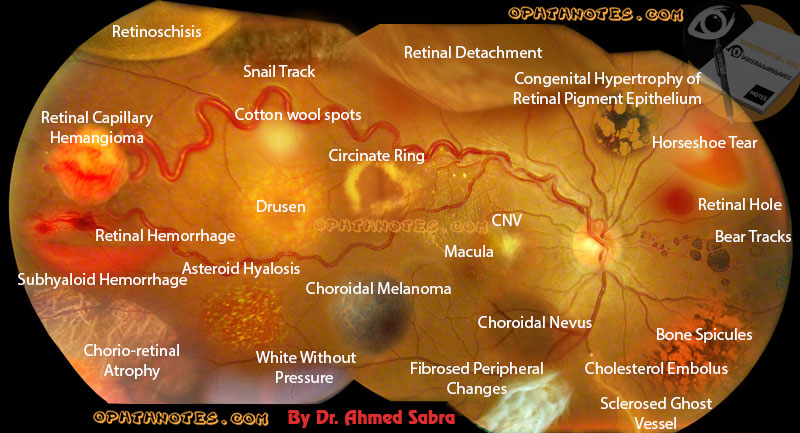
The first reported case of unilateral macular hemorrhage following uncomplicated, bilateral, simultaneous LASIK with femtosecond laser flap creation was in a patient without macular pathology. Fluorescein angiography showed some macular lesions compatible with lacquer cracks. Fundus examination showed multifocal subretinal macular and posterior pole hemorrhages. In one case of bilateral macular hemorrhage after LASIK, the patient's uncorrected visual acuity was in the 20/50 range at one day postop, and by 17 days after surgery his visual acuity had declined to the 20/200 range. Macular hemorrhage may occur after LASIK, even in the absence of previously identified risk factors, such as high myopia, pre-existing CNV, lacquer cracks and sudden changes in IOP associated with microkeratome-assisted flap creation. Retinal detachment occurred at a mean 24.6 ☒0.4 months after LASIK in 11 eyes (0.36 percent). In another recent study, the incidence of retinal disease after refractive surgery (including LASIK) was observed in 9,239 consecutive eyes (5,099 patients). Information regarding VA after LASIK and before the development of RRD was available in 24 eyes 45.8 percent (11/24) of eyes lost two or more lines of VA after vitreoretinal surgery. The anatomic success at final follow-up including reoperations was 90.3 percent (28/31). The anatomic success at final follow-up with one surgery was 87.1 percent (27/31). Final VA after RRD surgery improved two lines or more in 51.6 percent (16/31) of eyes.

Reasons for poor VA included: the development of proliferative vitreo-retinopathy (n=5) epiretinal membrane (n=1) chronicity of RRD (n=1) new breaks (n=1) displaced corneal flap (n=1) and cataract (n=1). Poor VA (20/200 or worse) occurred in 22.6 percent of eyes. Final VA was better than 20/200 in 77.4 percent of eyes. The mean follow-up after retinal surgery was 14 months (range: three to 34 months) and 38.7 percent of the 31 eyes (two patients refused surgery) had a final BCVA of 20/40 or better. Vitreoretinal surgery to repair RRD after LASIK was performed at a mean of 56 days (range: one day to 18 months) after the onset of visual symptoms. Retinal detachments were managed with vitrectomy, cryoretinopexy, scleral buckling, argon laser retinopexy and pneumatic retinopexy techniques. Eyes that developed a RRD had from -1.5 to -16 D of myopia (mean: -8.75 D) before LASIK. RRDs occurred between 12 days and 60 months (mean: 16.3 months) after LASIK. The frequency of RRD determined in our study is 0.08 percent (33/38,823). No patient had a history of any other ocular surgery after LASIK. In our series, 9 percent (3/33) of eyes that developed a RRD had some kind of enhancement after LASIK. Final visual acuity was defined as the BCVA at last follow-up examination, ranging from three to 34 months (mean: 14 months) after vitreo-retinal surgery to repair RRD after LASIK. Patients were followed for a mean of 48 months after LASIK (range: six to 60 months).įive vitreoretinal surgeons and 33 eyes (27 patients) that developed RRD after myopic LASIK participated in the study ( See Figure 1). Patients underwent surgical correction of myopia ranging from -0.75 to -29 D (mean: -6 D). 12 A total of 38,823 LASIK procedures (eyes) were performed during the five-year study period. We reviewed the medical records and obtained follow-up information on all patients in our files with RRD after LASIK for the correction of myopia at five institutions. 11Īlthough no cause-effect relationship between LASIK and retinal detachment can be inferred from the studies, the authors' cases suggest that LASIK may be associated with retinal detachment, particularly in highly myopic eyes. 10 A recent report involved four eyes that had early RRD within three months of LASIK for correction of high myopia. 9 Incidence rates for retinal detachment in myopic eyes after LASIK have been reported at 0.25 percent (and a mean best-corrected visual acuity of 20/45 after retinal surgery in one series) 5 and 0.22 percent.

Several studies have reported individual cases of retinal detachment after LASIK, including a bilateral retinal detachment associated with a giant retinal tear 8 and a case of rhegmatogenous retinal detachment. This article will review retinal complications that may occur after refractive surgery, with an emphasis on LASIK. Such reports include: optic neuropathy, 1 flap displacement, 2 retinal tears, 3 retinal detachments, 4 corneo-scleral perforations, 5 retinal hemorrhages, 5 macular hemorrhages, 6 macular holes 7 and choroidal neovascular membranes. Surgical advances in myopic correction since then, from automated lamellar keratoplasty to clear-lens extraction and LASIK, have all led to reports of postoperative retinal complications. Since the days of radial keratotomy, retinal complications have been reported after refractive surgery.


 0 kommentar(er)
0 kommentar(er)
